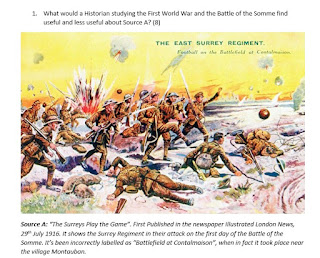Teaching in Teams & Class Notebook
My school rolled out Microsoft Teams to us in Summer 2018, and gave teachers the choice how far to use the new technology. All students were to be given a "Surface" laptop, but otherwise teachers were left to decide how far to adopt the new technology for the first year. Previously we had a "bring your own device" policy which meant that some students worked on a laptop, but most had files with paper and KS3 had exercise books. Some staff (me included) were using Google Classroom, but there was no College-wide tech policy.
This seemed like progress.
I decided to fully embrace the challenge so that all of my lessons would be done via Teams with all class work distributed via the Class Notebook. My rationale was that students would otherwise end up having some work on the virtual environment and some on paper in a folder or stuck into an exercise book; I wanted everything in one place. I also wanted to be working in one way for all my classes.
Needless to say, when the lockdown started in March 2020 I was overjoyed and fully ready for the challenge... not! I had an advantage over some of my colleagues because I had embraced the new tech early on. Not everyone in my classes liked it initially, and there were a surprising number of students who didn't like the technology. Not all "Zoomers" (thank you Wikipedia!) are digital natives.
Doubtless there are many colleagues out there who are using Teams / Class Notebook very effectively and don't need any help. However, I hoped that writing a blog might help anyone wondering how to use Teams in a History classroom; I appreciate that not everyone would want to do things the way I have!
Class Notebook
Let's start with the basics - I have taken to use the Class Notebook as a virtual version of what the students would otherwise have had in a file or exercise book, with the advantage they could never lose anything (teenagers have a habit of mis-filing paper, and although some students are well organised and diligent about filing material away, most are not and some are as disorganised in their work as they are in their own lives).
So - there are various sections for course admin, specification, class material, revision, and question guidance:
Most importantly I realised that keeing the lessons labelled clearly and simply is critical if the expectation is that at a future date they will need to look back at their work. Labelling each section of the lesson seemed sensible, but in retrospect needlessly complex and unfriendly when students want to look back on it:
Simplicity is all, so I have ended up doing this:
Lesson number only labelled with S, T or P for "Starter", "Task", and "Plenary".
Now, perhaps I can just give out electronic versions of the teaching resources I have been using for a while and otherwise just put my feet up! Easy, right?
Not so fast!
There are dull technical challenges to consider - what made sense before with a PowerPoint displayed by me on the Classroom screen with student handouts separately becomes many digital pages which are a slog to navigate through. I do miss the occasional discussion-then-reveal that could happen when using Powerpoint ("What do you think happened next? This happened next!"), but I think this is a small price to pay for clarity.
Students should not have to use valuable working memory in order to nagivate through lesson materials to start doing a task; being aware of cognitive load is vital.
Flicking between documents, which might make sense in the before times, with students using a text book to answer questions in their exercise books becomes more of a challenge when doing so on a single computer screen which involves flicking between apps. Again - we are putting unnecessary demants on the working memory in order to simply access tasks.
Page layout
In my first year using the Class Notebook, I constructed my lesson material direct into the page - it was easy and there was some flexibility in terms of layout. The down-side was that I thought it was not as clear as a traditional "handout" could be; students need lines to write on but these conflicted with any boxes I put on the page (also - this is an unnecessarily complex task which I don't think I had fully thought through. However it does illustrate the problem):
I'm conscious of not talking too much, and one of the points that Lemov made about working memory is that although there is some value in reading a piece of text outloud to a class, they can't process it at the same time; this has a tendency to overload working memory.
This has been heavily influenced by the Rosenshine model in mind, I have tried to structure my lessons accordingly. I have been breaking up the lesson into chunks with tasks that I explain, get students to work on for a short period, and then checking for knowledge.
However, as a teacher of a humanities subject modelling a task, then getting them to do it and checking for understanding has to be done differently to the way it is in, say, Maths.
I'll endevour to write something coherent about the way I have approched this in another post.







Comments
Post a Comment